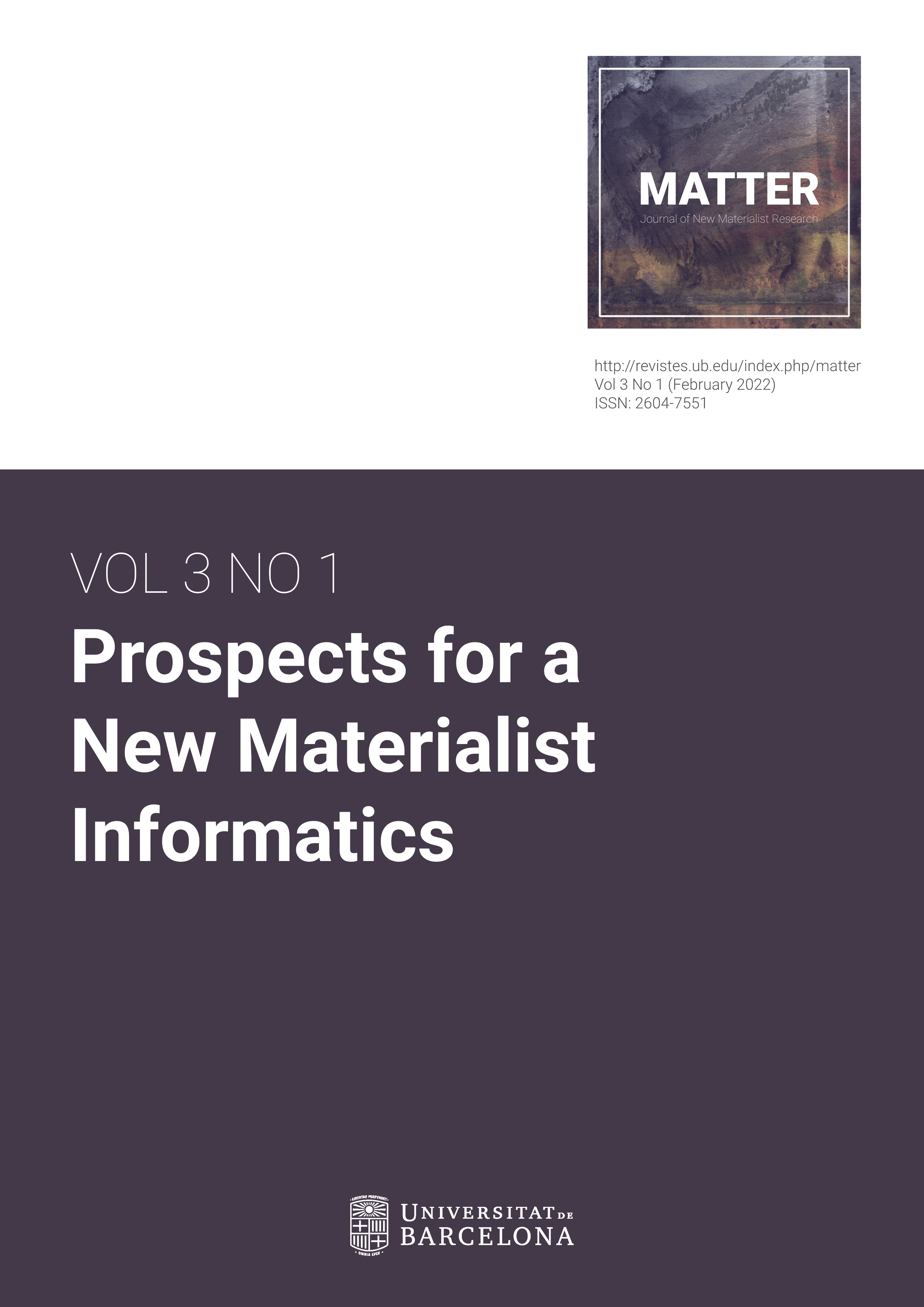Articulating Nomadic Identities of Radio Signals
DOI:
https://doi.org/10.1344/jnmr.v3i1.38959Keywords:
Radio signal; Digital archive; Nomadic theory; Machine reason; Identification.Abstract
This article presents a new materialist approach to artificial neural networks, based on experimental research in categorization of data on radio signals. Picking up on Rossi Braidotti’s nomadic theory and a number of new materialist perspectives on informatics, the article presents identification of radio signals as a process of articulating identities with data: nomadic identities that are informed by all the others, always established anew. As a resistance to the dominant understanding of data as discreet, the experiments discussed here demonstrate a way to work with a digital archive in a materialist and non-essentialist way. The output of experiments, data observatories, shows the capacity of machine learning techniques to challenge fixed dichotomies, such as human/nature, and their role in the way we think of identities. A data observatory is a navigation apparatus which can be used to orient oneself in the vast landscape of data on radio transmissions based on computable similarity. Nomadic identities render materiality of radio signals as digital information.
Downloads
References
Barad, Karen (2007). Meeting the universe halfway: Quantum physics and the entanglement of matter and meaning. Duke University Press.
Berry, David (Ed.). (2012). Understanding digital humanities. Palgrave Macmillan.
Bottazzi, Roberto (2018). Digital architecture beyond computers: Fragments of a cultural history of computational design. Bloomsbury Visual Arts.
Bottazzi, Roberto (2019). Crypto Architecture: Notes on Machine Learning and Design. In Micahel Robert Doyle, Selena Savić, & Vera Bühlmann (Eds.), Ghosts of Transparency: Shadows Cast and Shadows Cast Out. Birkhäuser. https://www.degruyter.com/document/doi/10.1515/9783035619171-002/html
Bowker, Geoffrey, & Star, Susan Leigh (2000). Sorting things out: Classification and its consequences (1st paperback edition). The MIT Press.
Braidotti, Rosi (2006). The Ethics of Becoming-Imperceptible. In C. V. Boundas (Ed.), Deleuze and philosophy (pp. 133–159). Edinburgh University Press.
Braidotti, Rosi (2011). Nomadic Subjects: Embodiment and Sexual Difference in Contemporary Feminist Theory, Second Edition. Columbia University Press.
Bühlmann, Vera (2013). Primary Abundance, Urban Philosophy—Information and The Form of Actuality. In L. Hovestadt & V. Bühlmann (Eds.), Metalithikum I. Birkhäuser Verlag GmbH.
Bühlmann, Vera (2020). Mathematics and Information in the Philosophy of Michel Serres. Bloomsbury Academic.
Bühlmann, Vera (2021). In Medias Naturae. Media Theory, 5(1), 231–252.
Colman, Felicity (2014). Digital Feminicity: Predication and Measurement, Materialist Informatics and Images. Artnodes, 14, 7–17.
Colman, Felicity, Bühlmann, Vera, O’Donnell, Aislinn, & van der Tuin, Iris (2018). Ethics of Coding. A Report on the Algorithmic Condition. H2020-EU.2.1.1. – INDUSTRIAL LEADERSHIP – Leadership in enabling and industrial technologies – Information and Communication Technologies.
Coole, Diana, & Frost, Samatha (2010). Introducing the New Materialisms. In Diana Coole & Samatha Frost (Eds.), New Materialisms: Ontology, Agency and Politics (pp. 1–43). Duke University Press. https://doi.org/10.1215/9780822392996-001
Deleuze, Gilles, & Guattari, Félix (1987). A thousand plateaus: Capitalism and schizophrenia. University of Minnesota Press.
D’Ignazio, Cathetine, & Klein, Lauren F. (2020). Data feminism. The MIT Press.
Dolphijn, Rick, & Van der Tuin, Iris (2012). New Materialism: Interviews and Cartographies. Open Humanities Press. https://doi.org/10.3998/ohp.11515701.0001.001
Haraway, Donna (1987). A manifesto for Cyborgs: Science, technology, and socialist feminism in the 1980s. Australian Feminist Studies, 2(4), 1–42. https://doi.org/10.1080/08164649.1987.9961538
Harding, Sandra (1986). The science question in feminism. Cornell University Press.
Hayles, N. Katherine (2017). Unthought: The power of the cognitive nonconscious. The University of Chicago Press.
Hayles, N. Katherine (2018). Writing//Posthuman: The Literary Text as Cognitive Assemblage. Theoretical Studies in Literature and Art, 3, 6–21.
Hovestadt, Ludger (2014). Cultivating the Generic: A Mathematically Inspired Pathway For Architects. In Ludger Hovestadt & Vera Bühlmann (Eds.), EigenArchitecture (pp. 7–67). Birkhäuser Verlag GmbH.
Juliano, Linzi, & Srinivasan, Ramesh (2012). Tagging it: Considering how ontologies limit the reading of identity. International Journal of Cultural Studies, 15(6), 615–627. https://doi.org/10.1177/1367877912451684
Kahn, Douglas (2013). Earth sound earth signal: Energies and earth magnitude in the arts. University of California Press.
Kitchin, Rob, & Dodge, Martin (2011). Code/Space. MIT Press.
Kohonen, Teuvo (1982). Self-organized formation of topologically correct feature maps. Biological Cybernetics, 43(1), 59–69. https://doi.org/10.1007/BF00337288
Kohonen, Teuvo, Oja, Erkki, Simula, Olli, Visa, Ari, & Kangas, Jari (1996). Engineering applications of the self-organizing map. Proceedings of the IEEE, 84(10), 1358–1384. https://doi.org/10.1109/5.537105
Miyazaki, Shintaro (2013). Urban sounds unheard-of: A media archaeology of ubiquitous infospheres. Continuum, 27(4), 514–522. https://doi.org/10.1080/10304312.2013.803302
Nadim, Tahani (2021). Database. In N. B. Thylstrup, D. Agostinho, A. Ring, C. D’Ignazio, & K. Veel (Eds.), Uncertain Archives: Critical Keywords for Big Data (pp. 125–132). MIT Press.
Nakamura, Lisa, & Haraway, Donna (2003). Prospects for a Materialist Informatics: An Interview with Donna Haraway. Electronic Book Review (Ebr), Technocapitalism. http://electronicbookreview.com/essay/prospects-for-a-materialist-informatics-an-interview-with-donna-haraway/
Parikka, Jussi (2010). Insect media: An archaeology of animals and technology. University of Minnesota Press.
Parikka, Jussi (2012). New Materialism as Media Theory: Medianatures and Dirty Matter. Communication and Critical/Cultural Studies, 9(1), 95–100. https://doi.org/10.1080/14791420.2011.626252
Pölzlbauer, Georg (2004). Survey and Comparison of Quality Measures for Self-Organizing Maps. In Ján Paralič, Georg Pölzlbauer, & Andreas Rauber (Eds.), Proceedings of the Fifth Workshop on Data Analysis (WDA’04) (pp. 67–82). Elfa Academic Press.
Posner, Miriam, & Klein, Lauren F. (2017). Editor’s Introduction: Data as Media. Feminist Media Histories, 3(3), 1–8. https://doi.org/10.1525/fmh.2017.3.3.1
Van der Tuin, Iris (2014). Diffraction as a Methodology for Feminist Onto-Epistemology: On Encountering Chantal Chawaf and Posthuman Interpellation. Parallax, 20(3), 231–244. https://doi.org/10.1080/13534645.2014.927631
Van der Tuin, Iris (2015). Generational Feminism: New Materialist Introduction to a Generative Approach. Lexington Books.
Vee, Annette (2017). Coding literacy: how computer programming is changing writing. The MIT Press.
Wang, Avery Li-chun (2003). An industrial-strength audio search algorithm. Proceedings of the 4th International Conference on Music Information Retrieval. https://doi.org/10.1.1.217.8882
Downloads
Published
Issue
Section
License
Copyright (c) 2022 Matter: Journal of New Materialist Research

This work is licensed under a Creative Commons Attribution 4.0 International License.
The authors who publish in this journal agree to the following terms:- Authors retain copyright and grant the journal the right of first publication.
- Texts will be published under a Creative Commons Attribution License that allows others to share the work, provided they include an acknowledgement of the work’s authorship, its initial publication in this journal and the terms of the license.






